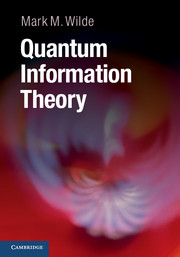Book contents
- Frontmatter
- Contents
- How To Use This Book
- Acknowledgments
- Part I Introduction
- Part II The Quantum Theory
- Part III Unit Quantum Protocols
- Part IV Tools of Quantum Shannon Theory
- 9 Distance Measures
- 10 Classical Information and Entropy
- 11 Quantum Information and Entropy
- 12 The Information of Quantum Channels
- 13 Classical Typicality
- 14 Quantum Typicality
- 15 The Packing Lemma
- 16 The Covering Lemma
- Part V Noiseless Quantum Shannon Theory
- Part VI Noisy Quantum Shannon Theory
- Appendix A Miscellaneous Mathematics
- Appendix B Monotonicity of Quantum Relative Entropy
- References
- Index
10 - Classical Information and Entropy
from Part IV - Tools of Quantum Shannon Theory
Published online by Cambridge University Press: 05 May 2013
- Frontmatter
- Contents
- How To Use This Book
- Acknowledgments
- Part I Introduction
- Part II The Quantum Theory
- Part III Unit Quantum Protocols
- Part IV Tools of Quantum Shannon Theory
- 9 Distance Measures
- 10 Classical Information and Entropy
- 11 Quantum Information and Entropy
- 12 The Information of Quantum Channels
- 13 Classical Typicality
- 14 Quantum Typicality
- 15 The Packing Lemma
- 16 The Covering Lemma
- Part V Noiseless Quantum Shannon Theory
- Part VI Noisy Quantum Shannon Theory
- Appendix A Miscellaneous Mathematics
- Appendix B Monotonicity of Quantum Relative Entropy
- References
- Index
Summary
All physical systems register bits of information, whether it be an atom, an electrical current, the location of a billiard ball, or a switch. Information can be classical, quantum, or a hybrid of both, depending on the system. For example, an atom or an electron or a superconducting system can register quantum information because the quantum theory applies to each of these systems, but we can safely argue that the location of a billiard ball registers classical information only. These atoms or electrons or superconducting systems can also register classical bits because it is always possible for a quantum system to register classical bits.
The term information, in the context of information theory, has a precise meaning that is somewhat different from our prior “everyday” experience with it. Recall that the notion of the physical bit refers to the physical representation of a bit, and the information bit is a measure of how much we learn from the outcome of a random experiment. Perhaps the word “surprise” better captures the notion of information as it applies in the context of information theory.
This chapter begins our formal study of classical information. Recall that Chapter 2 overviewed some of the major operational tasks in classical information theory. Here, our approach is somewhat different because our aim is to provide an intuitive understanding of information measures, in terms of the parties who have access to the classical systems.
- Type
- Chapter
- Information
- Quantum Information Theory , pp. 232 - 251Publisher: Cambridge University PressPrint publication year: 2013

